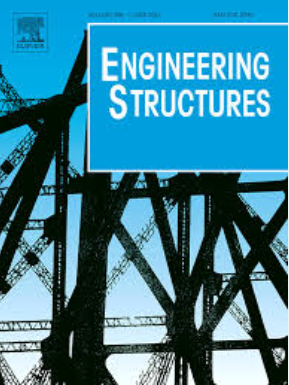剪力型摩擦钢桁架耦合梁的滞回模型
IF 6.4
1区 工程技术
Q1 ENGINEERING, CIVIL
引用次数: 0
摘要
传统的钢连接梁在地震后遭受无法修复的塑性损伤,需要昂贵的构件更换。为了解决这一问题,本研究提出了一种用于耦合墙系统的剪力型摩擦钢桁架耦合梁(SFTCB)。SFTCB将斜向腹板处的非弹性变形转化为非对称摩擦连接的滑动。通过将能量耗散限制在可替换的AFC上,SFTCB的主体在地震中保持弹性。耦合梁的震后恢复简化为AFC的替换。此外,SFTCB将刚度和强度解耦,从而表现出独立和灵活的设计过程。首先,介绍了SFTCB的结构和设计思想。随后,进行了准静力试验,验证了SFTCB的抗震性能。基于理论滞回曲线和试验滞回曲线,提出了SFTCB的滞回模型。该模型集成了六个参数,一半是理论推导,一半是经验校准。最后,通过有限元参数分析验证了所提模型和刚强解耦机理。结果表明,该模型的理论参数和经验参数偏差分别在10 %和18 %以内,可以接受。因此,该模型能够准确预测SFTCB的滞回特性,适用于SFTCB的抗震设计。本文章由计算机程序翻译,如有差异,请以英文原文为准。
Hysteretic model for shear-type friction steel truss coupling beams
Conventional steel coupling beams suffer from irreparable plastic damage after earthquakes, requiring costly member replacement. To address this issue, this study proposes a shear-type friction steel truss coupling beam (SFTCB) utilized in coupled wall systems. The SFTCB transforms the inelastic deformation at the diagonal web members into the sliding of asymmetric friction connections (AFC). By confining energy dissipation to the replaceable AFC, the main body of the SFTCB remains elastic during earthquakes. Post-earthquake recovery of coupling beams simplifies to AFC replacement. Moreover, the SFTCB decouples stiffness and strength, thereby exhibiting an independent and flexible design process. Firstly, the configuration and design concepts of the SFTCB were introduced. Sequentially, quasi-static tests were conducted to validate the seismic performance of the SFTCB. Based on both theoretical and test hysteretic curves, a hysteretic model was then proposed for the SFTCB. The model integrates six parameters, half derived theoretically and half calibrated empirically. Finally, the proposed model and the stiffness-strength decoupling mechanism were validated through finite element (FE) parametric analysis. The FE results validate the stiffness-strength decoupling mechanism and indicate that the theoretical and empirical parameters of the proposed model have acceptable deviations within 10 % and 18 %, respectively Therefore, the proposed hysteretic model can accurately predict the SFTCB’s hysteretic behavior and is suitable for seismic design of the SFTCB.
求助全文
通过发布文献求助,成功后即可免费获取论文全文。
去求助
来源期刊

Engineering Structures
工程技术-工程:土木
CiteScore
10.20
自引率
14.50%
发文量
1385
审稿时长
67 days
期刊介绍:
Engineering Structures provides a forum for a broad blend of scientific and technical papers to reflect the evolving needs of the structural engineering and structural mechanics communities. Particularly welcome are contributions dealing with applications of structural engineering and mechanics principles in all areas of technology. The journal aspires to a broad and integrated coverage of the effects of dynamic loadings and of the modelling techniques whereby the structural response to these loadings may be computed.
The scope of Engineering Structures encompasses, but is not restricted to, the following areas: infrastructure engineering; earthquake engineering; structure-fluid-soil interaction; wind engineering; fire engineering; blast engineering; structural reliability/stability; life assessment/integrity; structural health monitoring; multi-hazard engineering; structural dynamics; optimization; expert systems; experimental modelling; performance-based design; multiscale analysis; value engineering.
Topics of interest include: tall buildings; innovative structures; environmentally responsive structures; bridges; stadiums; commercial and public buildings; transmission towers; television and telecommunication masts; foldable structures; cooling towers; plates and shells; suspension structures; protective structures; smart structures; nuclear reactors; dams; pressure vessels; pipelines; tunnels.
Engineering Structures also publishes review articles, short communications and discussions, book reviews, and a diary on international events related to any aspect of structural engineering.
 求助内容:
求助内容: 应助结果提醒方式:
应助结果提醒方式:


